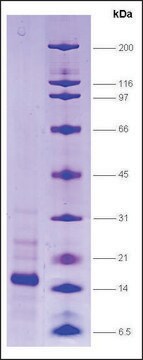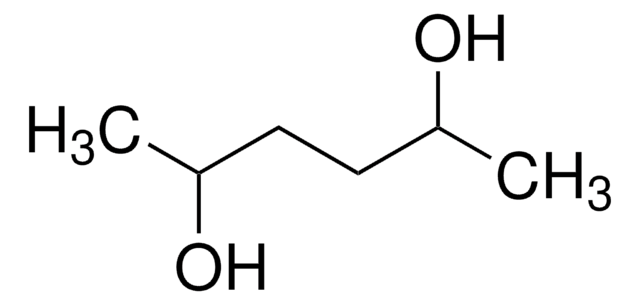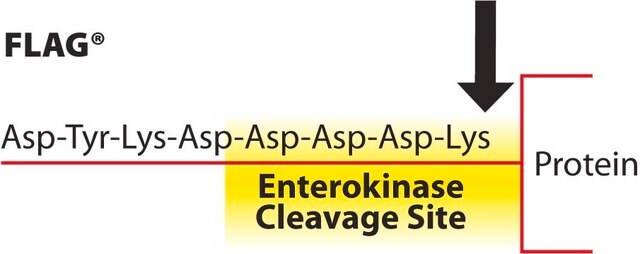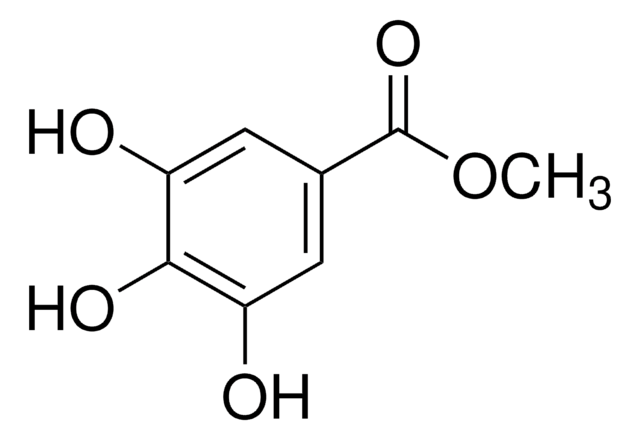推荐产品
产品名称
RNA聚合酶II,C端域,GST标记 人, recombinant, expressed in E. coli, ≥70% (SDS-PAGE)
生物源
human
重組細胞
expressed in E. coli
化驗
≥70% (SDS-PAGE)
形狀
frozen liquid
分子量
~68.1 kDa
包裝
pkg of 10 μg
儲存條件
avoid repeated freeze/thaw cycles
顏色
clear colorless
NCBI登錄號
UniProt登錄號
運輸包裝
dry ice
儲存溫度
−70°C
基因資訊
human ... POLR2A(5430)
生化/生理作用
The CTD works as a binding scaffold for nuclear factors through its phosphorylation. It is suggested to be also involved in chromatin structure modification, DNA damage/repair, protein degradation and synthesis, RNA degradation, snRNA (small nuclear RNA) modification, and snoRNP (small nucleolar ribonucleoprotein) biogenesis.
The carboxy-terminal repeat domain (CTD) of the largest subunit of RNA pol II contains tandem repeats of a heptapeptide sequence Tyr-Ser-Pro-Thr-Ser-Pro-Ser which is highly conserved among eukaryotic organisms. There are two forms of RNA pol II in vivo: IIO, which is extensively phosphorylated at the CTD, and IIA, which is not phosphorylated. The IIA form preferentially enters the pre-initiation complex (PIC), whereas IIO is found in the elongation complex. The kinase activity of TFIIH can mediate CTD phosphorylation, although other kinases, including Cdc2, Ctk1, the Srb10-Srb11 kinase-cyclin pair, and P-TEFb, have also been implicated in CTD phosphorylation. A phosphatase responsible for the dephosphorylation of the CTD has also been identified. CTD phosphatase activity is regulated by TFIIB and TFIIF. The CTD has also been implicated in pre-mRNA processing, most likely functioning as a platform for the recruitment and assembly of factors involved in pre-mRNA processing.
外觀
Clear and colorless frozen liquid solution
準備報告
Use a manual defrost freezer and avoid repeated freeze-thaw cycles. While working, please keep sample on ice.
儲存類別代碼
10 - Combustible liquids
水污染物質分類(WGK)
WGK 1
閃點(°F)
Not applicable
閃點(°C)
Not applicable
RNA polymerase II C-terminal domain required for enhancer-driven transcription.
Gerber HP, et al.
Nature, 374, 660-662 (1995)
Phosphorylation and functions of the RNA polymerase II CTD.
Phatnani HP and Greenleaf AL
Genes & Development, 20, 2922-2936 (2006)
T O'Brien et al.
Nature, 370(6484), 75-77 (1994-07-07)
The carboxy-terminal domain (CTD) of the large subunit of RNA polymerase II is essential in vivo, and is found in either an unphosphorylated (IIa) or hyperphosphorylated (IIo) form. The Drosophila uninduced hsp70 and hsp26 genes, and the constitutively expressed beta-1
H Lu et al.
Proceedings of the National Academy of Sciences of the United States of America, 88(22), 10004-10008 (1991-11-15)
The two forms of RNA polymerase II that exist in vivo, phosphorylated (IIO) and nonphosphorylated (IIA), were purified to apparent homogeneity from HeLa cells. The nonphosphorylated form preferentially binds to the preinitiation complex. RNA polymerase II in the complex was
The role of multisite phosphorylation in the regulation of RNA polymerase II activity.
M E Dahmus
Progress in nucleic acid research and molecular biology, 48, 143-179 (1994-01-01)
我们的科学家团队拥有各种研究领域经验,包括生命科学、材料科学、化学合成、色谱、分析及许多其他领域.
联系客户支持








